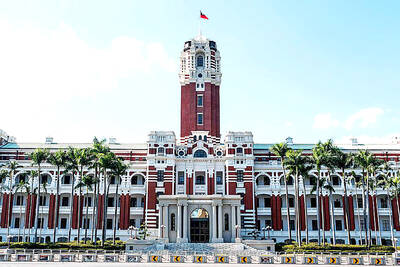The relationship between Taiwan and China is not one between two countries, but a type of special relationship across the Taiwan Strait, President Ma Ying-jeou (馬英九) has told a Mexican newspaper, in a marked departure from former president Lee Teng-hui’s (李登輝) special state-to-state model of relations.
“Basically, we don’t think the relationship between the two sides is one between two Chinas, but a special one,” Ma said in an interview with Sol de Mexico on Aug. 26, the Chinese text of which was released by the Presidential Office yesterday.
During the interview, the reporter asked questions in Spanish and Ma replied in Mandarin.
Ma said the Constitution of the Republic of China (ROC) does not allow the existence of another country on its territory, nor does the Constitution of the People’s Republic of China (PRC).
“The relationship is a special one, but that relationship is not between two countries,” he was quoted as saying in the transcript. “While it is unlikely that double recognition of both sides of the Taiwan Strait can be obtained from any foreign country, we must maintain a peaceful and prosperous relationship with Beijing and at the same time we would like to see both sides enjoy dignity in the international community. This is our goal.”
Ma said that while both sides could not resolve the dispute of Taiwan’s sovereignty, Taipei and Beijing reached a consensus in 1992.
Under the so-called “1992 consensus,” Ma said each side accepted the principle of “one China” but agreed to have its own interpretation of what it meant.
While there were no immediate answers for the sovereignty issue, Ma said the government should not waste time and effort trying to resolve it. Instead, the government should focus its energy on more urgent issues that require both sides to attend to. Such issues were what his administration has been pushing, he said.
Ma said that while the ROC left China in 1949, it did not disappear from the surface of the Earth. He hoped both sides of the Strait would refrain from engaging in malicious competition on the diplomatic front.
As each side maintained relations with its own diplomatic allies, they could develop non-diplomatic relations with each other’s allies.
“Such peaceful coexistence is the most ideal way for interactions between the two sides,” he was quoted as saying in the transcript.
Presidential Office Spokesman Wang Yu-chi (王郁琦) said yesterday that the cross-strait relationship was not one between two countries but a special one defined by the 11th amendment to the ROC Constitution.
The article describes Taiwan as the “free region” and China as the “mainland region.” Wang said the two regions are equal and have two ruling authorities whose relationship is not between the central and local governments but one that is equal between the “Taiwan region” and the “mainland region.”
Wang said that while Ma has redefined cross-strait relations and proposed to assert sovereignty and shelve disputes, Ma’s policy was not a concession or surrender. Although both sides have different claims over their territory and the disputes over sovereignty are difficult to resolve, Wang said the administration would protect the sovereignty of the ROC, insist on the “three nos” and continue to extend goodwill to Beijing.
The “three nos” refers to no discussion of unification with Beijing during Ma’s presidency, no pursuit of de jure Taiwan independence and no use of military force to resolve the Taiwan issue.

The CIA has a message for Chinese government officials worried about their place in Chinese President Xi Jinping’s (習近平) government: Come work with us. The agency released two Mandarin-language videos on social media on Thursday inviting disgruntled officials to contact the CIA. The recruitment videos posted on YouTube and X racked up more than 5 million views combined in their first day. The outreach comes as CIA Director John Ratcliffe has vowed to boost the agency’s use of intelligence from human sources and its focus on China, which has recently targeted US officials with its own espionage operations. The videos are “aimed at

STEADFAST FRIEND: The bills encourage increased Taiwan-US engagement and address China’s distortion of UN Resolution 2758 to isolate Taiwan internationally The Presidential Office yesterday thanked the US House of Representatives for unanimously passing two Taiwan-related bills highlighting its solid support for Taiwan’s democracy and global participation, and for deepening bilateral relations. One of the bills, the Taiwan Assurance Implementation Act, requires the US Department of State to periodically review its guidelines for engagement with Taiwan, and report to the US Congress on the guidelines and plans to lift self-imposed limitations on US-Taiwan engagement. The other bill is the Taiwan International Solidarity Act, which clarifies that UN Resolution 2758 does not address the issue of the representation of Taiwan or its people in

US Indo-Pacific Commander Admiral Samuel Paparo on Friday expressed concern over the rate at which China is diversifying its military exercises, the Financial Times (FT) reported on Saturday. “The rates of change on the depth and breadth of their exercises is the one non-linear effect that I’ve seen in the last year that wakes me up at night or keeps me up at night,” Paparo was quoted by FT as saying while attending the annual Sedona Forum at the McCain Institute in Arizona. Paparo also expressed concern over the speed with which China was expanding its military. While the US

SHIFT: Taiwan’s better-than-expected first-quarter GDP and signs of weakness in the US have driven global capital back to emerging markets, the central bank head said The central bank yesterday blamed market speculation for the steep rise in the local currency, and urged exporters and financial institutions to stay calm and stop panic sell-offs to avoid hurting their own profitability. The nation’s top monetary policymaker said that it would step in, if necessary, to maintain order and stability in the foreign exchange market. The remarks came as the NT dollar yesterday closed up NT$0.919 to NT$30.145 against the US dollar in Taipei trading, after rising as high as NT$29.59 in intraday trading. The local currency has surged 5.85 percent against the greenback over the past two sessions, central